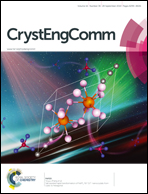Triazole-directed hydrogen-bonded structures of cationic iridium(iii) complexes†
Abstract
Despite the differing size of the Cl− and PF6− counter-ions, the structures of the heteroleptic iridium(III) complexes, [Ir(dFphtl)2(btl)]Cl, [1]Cl, and [Ir(dFphtl)2(btl)]PF6, [1]PF6, (where dFphtl = 1-benzyl-4-(2,4-difluorophenyl)-1H-1,2,3-triazole and btl = 1,1′-dibenzyl-4,4′-bi-1H-1,2,3-triazolyl) are found to exhibit similar morphologies in which both structures adopt hydrogen-bonded networks driven by the hydrogen-bond donor and acceptor demands of the triazole functional group. The triazole thus can be used as a supramolecular synthon to control the internuclear distance in the solid-state.


 Please wait while we load your content...
Please wait while we load your content...